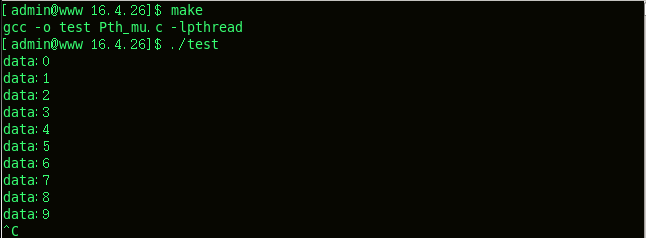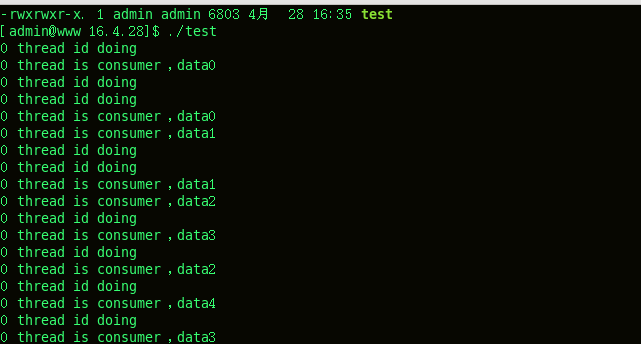Linux:生产者与消费者模式
来源:互联网 发布:淘宝时尚潘多拉代购点 编辑:程序博客网 时间:2024/05/23 00:21
生产者:生产数据
消费者:消费数据
提供场所:缓冲区,eg:超市
生产者消费者特点:三种关系,两类人,一个场所
三种关系指的是:生产者与生产者之间是互斥关系
消费者与消费者之间是互斥关系
生产者与消费者之间是同步与互斥关系
两类人:生产者,消费者
一个场所:存储数据(此处用带头单链表实现)
单生产者单消费者模式:此例取数据方式为FIFO先进先出。
利用互斥锁实现单生产者单消费者模式。
#include<stdio.h>#include<malloc.h>#include<pthread.h>typedef int _dataType;typedef int *_dataType_p;typedef struct _node{_dataType data;struct _node* next;}node,*nodep,**nodepp;nodep head = NULL;pthread_mutex_t mutex = PTHREAD_MUTEX_INITIALIZER;nodep buyNode(_dataType val){nodep tmp = (nodep)malloc(sizeof(node));if(tmp!= NULL){tmp->data = val;tmp->next = NULL;return tmp;}return NULL;}void init(nodepp head){*head = buyNode(0);}//存在头节点。void push_list(nodep head,_dataType val){nodep tmp = buyNode(val);tmp->next = head->next;head->next = tmp;}int pop_back_list(nodep head,_dataType_p pval){//当之存在一个哨兵位的时候.if(NULL == head->next)return -1;nodep index = head;while(NULL != index->next->next){ index = index->next;}nodep del = index->next;*pval = del->data;index->next = del->next;free(del);return 0;}void* product(void* arg){_dataType i = 0;while(1){sleep(1);pthread_mutex_lock(&mutex);push_list(head,i++);pthread_mutex_unlock(&mutex);}pthread_exit((void *)1);}void* consumer(void *arg){_dataType val = 0;while(1){sleep(2);pthread_mutex_lock(&mutex);if(pop_back_list(head,&val) == -1){pthread_mutex_unlock(&mutex);continue;}printf("data:%d\n",val);pthread_mutex_unlock(&mutex);}pthread_exit((void *)1);}int main(){pthread_t tid1,tid2;init(&head);pthread_create(&tid1,NULL,product,NULL);pthread_create(&tid2,NULL,consumer,NULL);pthread_join(tid1,NULL);pthread_join(tid2,NULL);free(head);pthread_mutex_destroy(&mutex);return 0;}运行结果:
 、
、
然后我们说一说条件变量:
线程间的同步还有这样一种情况:线程A需要等某个条件成立才能继续往下执行,现在这个条
件不成立,线程A就阻塞等待,而线程B在执行过程中使这个条件成立了,就唤醒线程A继续执
行。 在pthread库中通过条件变量(Condition Variable)来阻塞等待一个条件,或者唤醒等待这个
条件的线程。Condition Variable用pthread_cond_t类型的变量表示,可以这样初始化和销毁:

返回值:成功返回0,失败返回错误号。
和Mutex的初始化和销毁类似,pthread_cond_init函数初始化.一个Condition Variable,attr参数为
NULL则表.示缺省属性,pthread_cond_destroy函数销毁.一个Condition Variable。如果Condition
Variable是静态分配的,也可以.用宏定义PTHEAD_COND_INITIALIZER初始化,相当于 .用
pthread_cond_init函数初始化并且attr参数为NULL。Condition Variable的操作可以
用下列函数:


返回值:成功返回0,失败返回错误号。
可见,一个Condition Variable总是和一个Mutex搭配使用的。一个线程可以调用
pthread_cond_wait在一个Condition Variable上阻塞等待,这个函数做以下三步操作:
1. 释放Mutex
2. 阻塞等待
3. 当被唤醒时,重新获得Mutex并返回
pthread_cond_timedwait函数还有一个额外的参数可以设定等待超时,如果到达了abstime所指定的时刻仍然没有别的线程来唤醒当前线程,就返回ETIMEDOUT。一个线程可以调用
pthread_cond_signal唤醒在某个Condition Variable上等待的另一个线程,也可以调用
pthread_cond_broadcast唤醒在这个Condition Variable上等待的所有线程。
我们用条件变量来写一个单生产者单消费者模式:
#include<stdio.h>#include<malloc.h>#include<pthread.h>typedef int _dataType;typedef int *_dataType_p;typedef struct _node{_dataType data;struct _node* next;}node,*nodep,**nodepp;nodep head = NULL;pthread_mutex_t mutex = PTHREAD_MUTEX_INITIALIZER;pthread_cond_t cond = PTHREAD_COND_INITIALIZER;nodep buyNode(_dataType val){nodep tmp = (nodep)malloc(sizeof(node));if(tmp!= NULL){tmp->data = val;tmp->next = NULL;return tmp;}return NULL;}void init(nodepp head){*head = buyNode(0);}void push_list(nodep head,_dataType val){nodep tmp = buyNode(val);tmp->next = head->next;head->next = tmp;}int pop_list(nodep head,_dataType_p pval){if(NULL == head->next)return -1;nodep del = head->next;*pval = del->data;head->next = del->next;free(del);return 0;}void* product(void* arg){_dataType i = 0;while(1){sleep(1);pthread_mutex_lock(&mutex);push_list(head,i++);pthread_cond_signal(&cond);pthread_mutex_unlock(&mutex);}pthread_exit((void *)1);}void* consumer(void *arg){_dataType val = 0;while(1){sleep(1);pthread_mutex_lock(&mutex);if(pop_list(head,&val) == -1)pthread_cond_wait(&cond,&mutex);printf("data:%d\n",val);pthread_mutex_unlock(&mutex);}pthread_exit((void *)1);}int main(){pthread_t tid1,tid2;init(&head);pthread_create(&tid1,NULL,product,NULL);pthread_create(&tid2,NULL,consumer,NULL);pthread_join(tid1,NULL);pthread_join(tid2,NULL);free(head);pthread_mutex_destroy(&mutex);return 0;}运行结果同互斥锁一样。
信号量:
Mutex变量是非0即1的,可看作一种资源的可用数量,初始化时Mutex是1,表示有一个可用资源, 加锁时获得该资源,将Mutex减到0,表示不再有可用资源,解锁时释放该资源,将Mutex重新加到1,表示又有了一个可 用资源。
信号量(Semaphore)和Mutex类似,表示可用资源的数量,和Mutex不同的是这个数量可以大于
1。即,如果信号量描述的资源数目是1时,此时的信号量和互斥锁相同!
本节介绍的是POSIX semaphore库函数,详见sem_overview(7),这种信号量不仅可用于同一进程 的线程间同步,也可用于不同进程间的同步。
semaphore变量的类型为sem_t,sem_init()初始化一个semaphore变量,value参数表示可用资源的数量,pshared参数为0表示信号量用于同一进程的线程间同步,在用完semaphore变量之后应该调用sem_destroy()释放与semaphore相关的资源。

调用sem_wait()可以获得资源(P操作),使semaphore的值减1,如果调用sem_wait()时
semaphore的值已 经是0,则挂起等待。如果不希望挂起等待,可以调用sem_trywait() 。调用
sem_post() 可以释放资源(V操作),使semaphore 的值加1,同时唤醒挂起等待的线程。
上面生产者-消费者的例子是基于链表的,其空间可以动态分配,现在基于固定大小的环形队
列重写这个程序(POSIX信号量):
#include<stdio.h>#include<pthread.h>#include<semaphore.h>#define _SEM_PRO_ 20#define _SEM_COM_ 0typedef int _dataType;_dataType blank[_SEM_PRO_];sem_t sem_product;sem_t sem_consumer;void *product(void *arg){int index = 0;int count = 0;while(1){sleep(rand()%5);sem_wait(&sem_product);blank[index++] = count ++;sem_post(&sem_consumer);index %= _SEM_PRO_;}pthread_exit((void *)1);}void* consumer(void * arg){int index = 0;while(1){sem_wait(&sem_consumer);printf("data%d\n",blank[index++]);sem_post(&sem_product);index %= _SEM_PRO_;}pthread_exit((void*)1);}int main(){pthread_t tid1,tid2;sem_init(&sem_product,0,20);sem_init(&sem_consumer,0,0);pthread_create(&tid1,NULL,product,NULL);pthread_create(&tid2,NULL,consumer,NULL);pthread_join(tid1,NULL);pthread_join(tid2,NULL);sem_destroy(&sem_product);sem_destroy(&sem_consumer);return 0;}运行结果同上。
最后我们运用信号量来实现一个多消费者多生产者模式:
#include<stdio.h>#include<pthread.h>#include<semaphore.h>#define _SEM_PRO_ 20#define _SEM_COM_ 0typedef int _dataType;_dataType blank[_SEM_PRO_];sem_t sem_product;sem_t sem_consumer;pthread_mutex_t mutex_product = PTHREAD_MUTEX_INITIALIZER;pthread_mutex_t mutex_consumer = PTHREAD_MUTEX_INITIALIZER;void *product(void *arg){int index = 0;int count = 0;while(1){sleep(rand()%5);sem_wait(&sem_product);pthread_mutex_lock(&mutex_product);printf("%d thread id doing\n",(int )arg);blank[index++] = count ++;index %= _SEM_PRO_;pthread_mutex_unlock(&mutex_product);sem_post(&sem_consumer);}pthread_exit((void *)1);}void* consumer(void * arg){int index = 0;while(1){sem_wait(&sem_consumer);pthread_mutex_lock(&mutex_consumer);printf("%d thread is consumer ,data%d\n",(int)arg,blank[index++]);index %= _SEM_PRO_;pthread_mutex_unlock(&mutex_consumer);sem_post(&sem_product);}pthread_exit((void*)1);}int main(){pthread_t tid1,tid2,tid3,tid4;sem_init(&sem_product,0,20);sem_init(&sem_consumer,0,0);pthread_create(&tid1,NULL,product,NULL);pthread_create(&tid1,NULL,product,NULL);pthread_create(&tid3,NULL,consumer,NULL);pthread_create(&tid4,NULL,consumer,NULL);pthread_join(tid1,NULL);pthread_join(tid2,NULL);pthread_join(tid3,NULL);pthread_join(tid4,NULL);sem_destroy(&sem_product);sem_destroy(&sem_consumer);pthread_mutex_destroy(&mutex_product);pthread_mutex_destroy(&mutex_consumer);return 0;}运行结果:

总结:
其实本篇是借助生产者消费者模式来讲解线程的互斥锁,条件变量,信号量的操作。
对于生产者/消费者模型我们只需要记住三种关系,两类人,一个场所
三种关系指的是:生产者与生产者之间是互斥关系
消费者与消费者之间是互斥关系
生产者与消费者之间是同步与互斥关系
两类人:生产者,消费者
一个场所:存储数据。
然后对于生产者/消费者我以后会单独写一篇博客进行描述。
一定要熟悉运用本篇中的线程操作函数。
本文出自 “剩蛋君” 博客,请务必保留此出处http://memory73.blog.51cto.com/10530560/1769739
- Linux:生产者与消费者模式
- 消费者与生产者模式
- 消费者与生产者模式
- 消费者与生产者模式
- 生产者与消费者模式
- 生产者与消费者模式
- 生产者与消费者模式
- 生产者与消费者模式
- 生产者与消费者模式
- 生产者与消费者模式
- Linux--生产者与消费者
- Linux--生产者与消费者
- 消费者与生产者模式2
- 深入生产者与消费者模式
- JAVA 生产者与消费者模式
- Linux多线程生产者与消费者
- 设计模式之:生产者与消费者模式
- 同步线程--生产者与消费者模式
- 设计模式之——建设者设计模式
- Linux进程间通信:共享内存
- 【C/C++】排序总结
- Linux之线程:同步与互斥
- Linux:死锁问题
- Linux:生产者与消费者模式
- Linux:各种锁
- Linux:信号(上)
- 【C语言】函数指针与回调函数
- 线程安全与可重入函数
- Linux:信号(下)
- Linux:例行性工作
- 互联网协议相关知识
- Linux:守护进程


